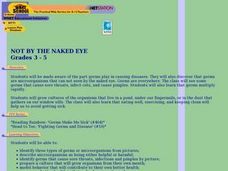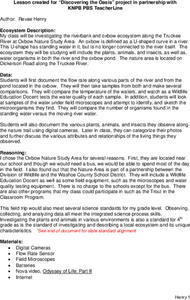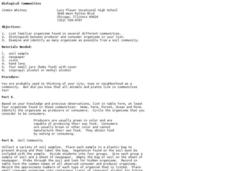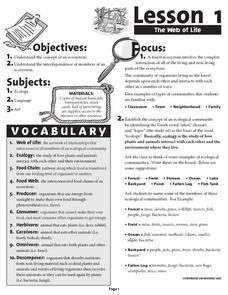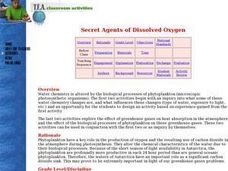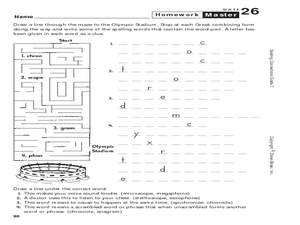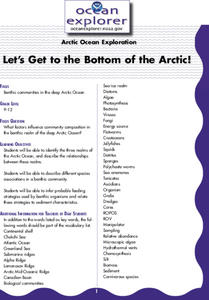Curated OER
Water Purification
Students develop an understanding and appreciation of water purification techniques and their implications for health maintenance.
Curated OER
Home Sweet Home
Students examine the animals that live in trees. They identify their sounds, footprints and droppings. They draw pictures of the animals as well.
Curated OER
Seeing Cells
Sixth graders study living cells and their functioning units. In this cell lesson students color cell diagrams, answer questions and discuss the differences between plant and animal cells.
Curated OER
Barnacles: Harder than Cement
Fourth graders watch the movements of the complex animal hidden inside the tiny barnacle shells. This lesson allows students to study the behavior, adaptation, and larval stage of the barnacle.
Curated OER
Cell Theory, Plant And Animal Cell Comparison
Tenth graders study plant and animal cells. In this investigative lesson students draw their own animal cells and label them.
Curated OER
Zebra, Zebra Where Are Your Stripes?
Students observe the embryological development in the zebrafish. Developmental hierarchy from three germ layers is studied in depth. Research is validated on the body plan of the embryo.
Curated OER
Discovering the Oasis
Fourth graders investigate riverbanks and oxbox ecosystem at the Truckee River. They observe the plants, animals, insects and water organisms located there. Students document water samples, flow and then categorize them in class. This...
Curated OER
Biological Communities
Students identify consumers and producers in different communities. Students collect a variety of soil samples and record organisms found in the samples.
Curated OER
Relationships and Biodiversity
Students examine diversity on the planet and the differences within a species. In this investigative instructional activity students complete a lab that allows students to better understand the relatedness between plants.
Curated OER
The Web of Life
Students participate in a game in which they discover the balance of life in the ocean. They identify different organisms that rely on different types of food. They answer questions to complete the lesson.
Curated OER
Mineral or Maceral Mosaic
Students study about geologists and their job. They also study that rocks are made up of minerals and organic material by conducting an experiment where they create their own "granite" or "coal".
Curated OER
Secret Agents of Dissolved Oxygen
Students determine the changes in different types of water in a sealed container over time. They investigate how to measure dissolved oxygen, temperature, and carbon dioxide with calculator or computer probe-ware. Students determine the...
Curated OER
Your Kidneys
In this kidneys worksheet, students review the structure and function of the kidneys in the human body. This worksheet has 18 fill in the blank statements.
Curated OER
Spelling Maze: Greek Roots
In this spelling worksheet, students complete a maze to the Olympic Stadium. Students stop at each Greek root and write words with that root. There is no spelling list on this page.
Curated OER
Let's Get to the Bottom of the Arctic!
Students identify the three realms of the Arctic Ocean, and describe the relationships between these realms. They describe different species associations in a benthic community.
Science Struck
Science Struck: A Study of the Microscope and Its Functions
Uses illustrations with labels to complement a detailed examination of the parts and functions of a light microscope and an electron microscope.
Other
University of Delaware: Virtual Compound Microscope
This virtual microscope is ideal for learning how to properly use a microscope. Users can turn knobs and dials, throw switches, move levers, change lenses, select a specimen, and adjust oculars. Watch the seven minute video for an...
Science Struck
Science Struck: Compound Microscope: Basics, Functionality, and Uses
Explains what a compound microscope is, the different parts, how it works, and what it is used for.
What2Learn
What2 Learn: The Parts of a Microscope
An activity where students can use the interactive diagram to label the major parts of a microscope.
Other
Southern Microscope Service's Home Page
A series of pages explaining how microscopes work, the parts of a microscopes, the techniques of using a microscope, and other useful information.
My Science Site
Bj's Science: Microscope Diagram [Pdf]
Site is simply a picture of a microscope that has numbers that correspond with each part of it. No answers are provided. A good reproducible if you are looking for a detailed view of the different microscope parts.
TeachEngineering
Teach Engineering: Imaging Dna Structure
Students are introduced to the latest imaging methods used to visualize molecular structures and the method of electrophoresis that is used to identify and compare genetic code (DNA). Students should already have basic knowledge of...

